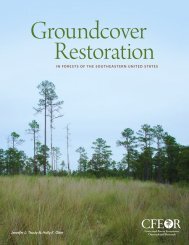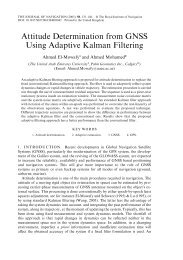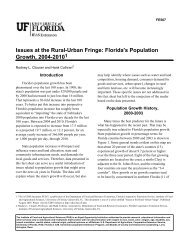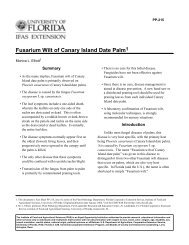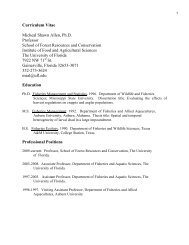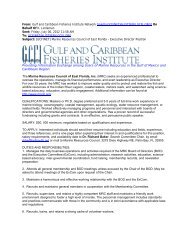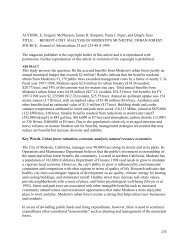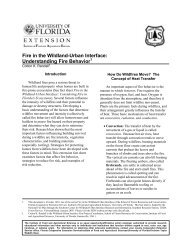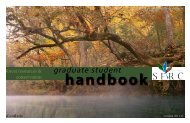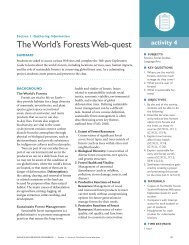Longleaf Pine Forest Restoration & Management - School of Forest ...
Longleaf Pine Forest Restoration & Management - School of Forest ...
Longleaf Pine Forest Restoration & Management - School of Forest ...
Create successful ePaper yourself
Turn your PDF publications into a flip-book with our unique Google optimized e-Paper software.
<strong>Management</strong> Practices to Support Increased Biodiversity in Managed Loblolly <strong>Pine</strong>.... 5<br />
Other Considerations<br />
The management practices described in this<br />
paper are geared towards increasing stand-level<br />
biodiversity. Ultimately, though, a landscape-level<br />
approach is needed. A variety <strong>of</strong> different stand<br />
structures and age classes should be present on the<br />
landscape in order to support the full range <strong>of</strong><br />
biodiversity (Marion et al. 1986, Moore and Allen<br />
1999, Oliver 1992). The size, shape, and spatial<br />
arrangement <strong>of</strong> these structures are also important.<br />
For landowners with large areas <strong>of</strong> contiguous<br />
holdings, a landscape management approach to<br />
providing for biodiversity may be feasible. When the<br />
landscape is broken up among different ownerships,<br />
landscape management requires coordination<br />
between different landowners with different needs<br />
and goals. The issues involved with such coordination<br />
are beyond the scope <strong>of</strong> this review. However,<br />
maintaining biodiversity at the landscape level<br />
depends on a collection <strong>of</strong> stand-level decisions. If<br />
individual landowners employ practices to increase<br />
stand-level biodiversity, their practices are likely to<br />
support significant increases in biodiversity across the<br />
landscape.<br />
Another important consideration when managing<br />
for biodiversity is land use history. Hedman et al.<br />
(2000) found that understory vegetation composition<br />
and abundance is driven more by previous land use<br />
(i.e. agriculture) than by forest management practices<br />
within the past 35 years. Plantations established on<br />
old field sites do not have biological legacies such as<br />
seeds and rootstocks that are present in plantations<br />
established on cutover lands (Baker and Hunter<br />
2002). Because <strong>of</strong> this, old field sites tend to have<br />
low understory diversity regardless <strong>of</strong> management<br />
practices (Hedman et al. 2000, Marion and Harris<br />
1982, Marion et al. 1986). On the other hand, old field<br />
sites have greater pine growth and yield and can<br />
produce more wood per area <strong>of</strong> land (Yin and Sedjo<br />
2001). Thus, intensive timber management that<br />
maximizes wood production and economic return<br />
could be focused on old field sites where biodiversity<br />
is likely to be poor regardless <strong>of</strong> management<br />
practices. Likewise, practices to improve biodiversity<br />
should be targeted to cutover lands.<br />
Finally, economic considerations may influence<br />
options to increase biodiversity. Intensively managed<br />
plantations are business enterprises for which<br />
landowners will expect some level <strong>of</strong> economic<br />
return. There are various costs associated with<br />
managing for increased biodiversity which create<br />
trade-<strong>of</strong>fs between biodiversity and economic returns.<br />
If management practices are too costly, they are<br />
unlikely to be implemented on private lands.<br />
<strong>Management</strong> strategies that balance both biodiversity<br />
and economic objectives should be identified.<br />
The potential for increased hunting lease revenue<br />
may help <strong>of</strong>fset the costs <strong>of</strong> managing for increased<br />
biodiversity. Hunting leases can provide significant<br />
revenue, especially if there is quality wildlife habitat<br />
(Baker and Hunter 2002, Johnson 1995, Jones et al.<br />
2001). However, ownership size may limit these<br />
opportunities.<br />
Summary<br />
Maintenance <strong>of</strong> biodiversity is a concern in the<br />
intensively managed loblolly pine plantations that are<br />
increasingly prevalent in the southeastern United<br />
States, but it is feasible with a number <strong>of</strong> stand-level<br />
management practices. The overall key to providing<br />
for biodiversity is to provide structural diversity. An<br />
open stand structure with a diverse, productive<br />
grass-herb understory is similar to the natural,<br />
fire-maintained pine communities that were<br />
historically present and can support a broad suite <strong>of</strong><br />
plants and wildlife.<br />
Maintaining an open canopy with a diverse<br />
understory can be achieved by thinning early and<br />
<strong>of</strong>ten in the rotation. However, this may allow a dense<br />
hardwood midstory to develop which would shade<br />
out the understory and negate the benefits <strong>of</strong> thinning.<br />
Consequently, it will be necessary to control<br />
hardwoods, either by prescribed burning or with<br />
mid-rotation herbicide applications, but hardwoods<br />
should not be eliminated entirely because a<br />
mast-producing component is necessary to provide<br />
wildlife food and structural diversity.<br />
Light to moderate site preparation is best for<br />
biodiversity, and mechanical methods may perform<br />
better in this respect than herbicides. Fertilization can<br />
benefit wildlife by increasing understory growth, but



